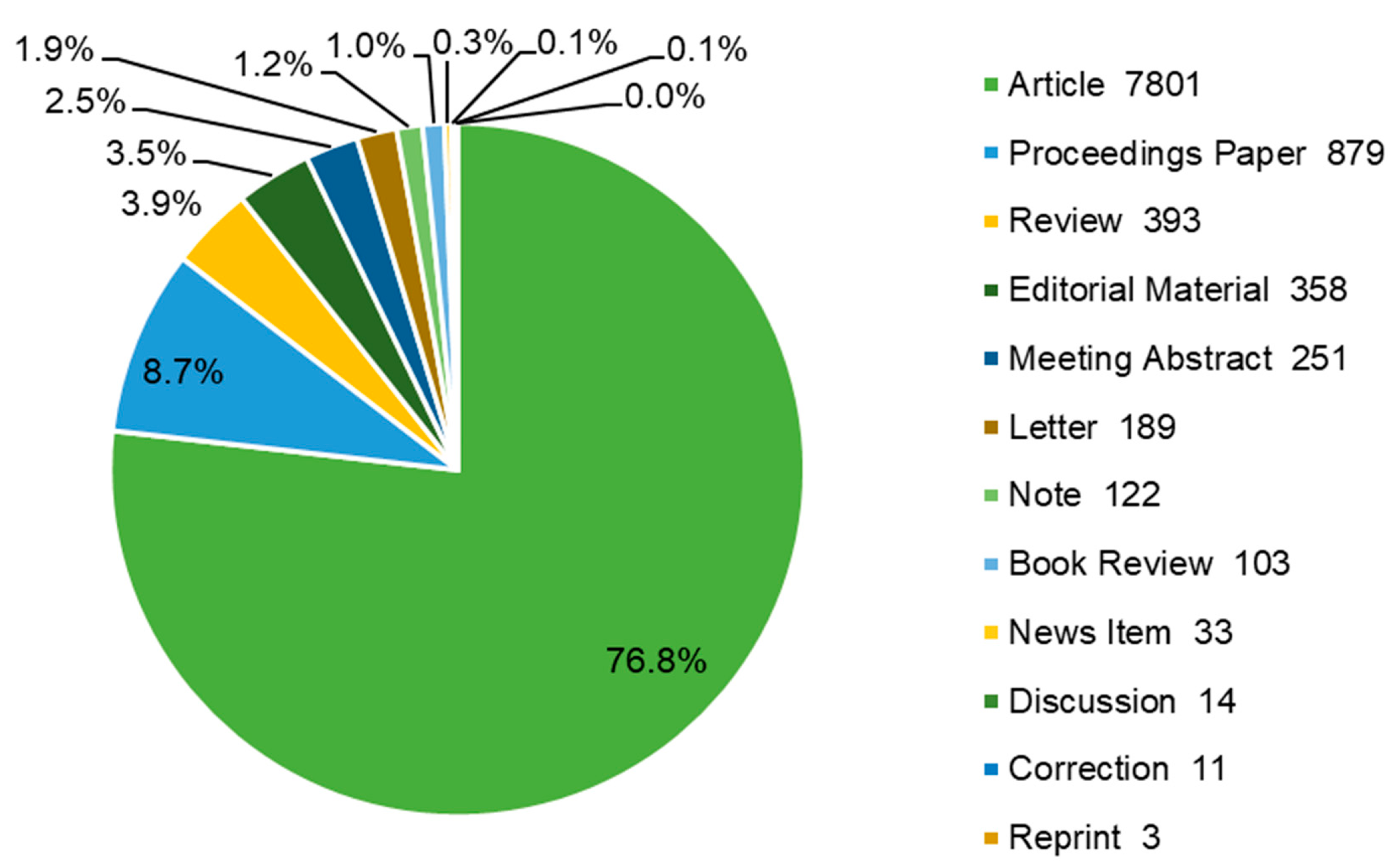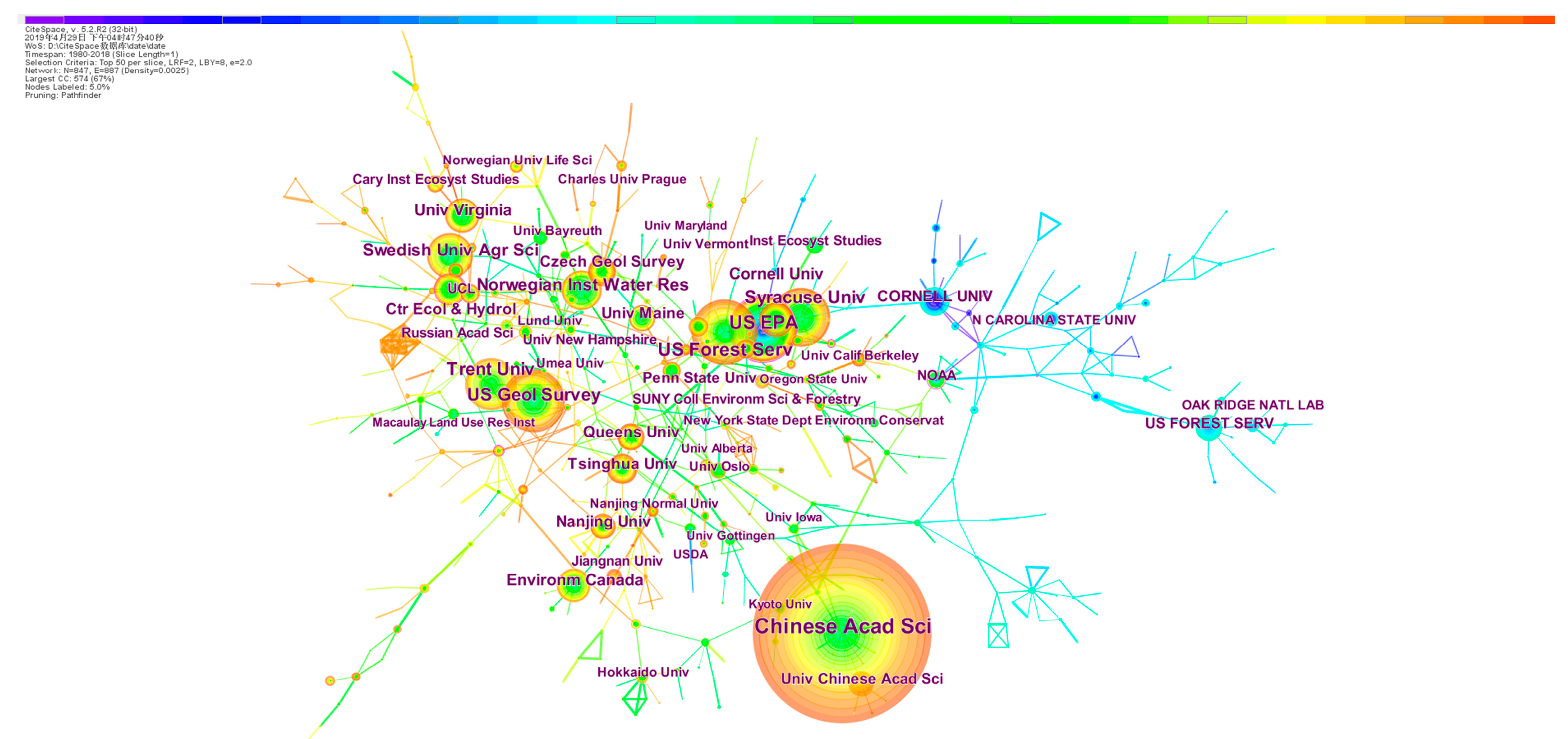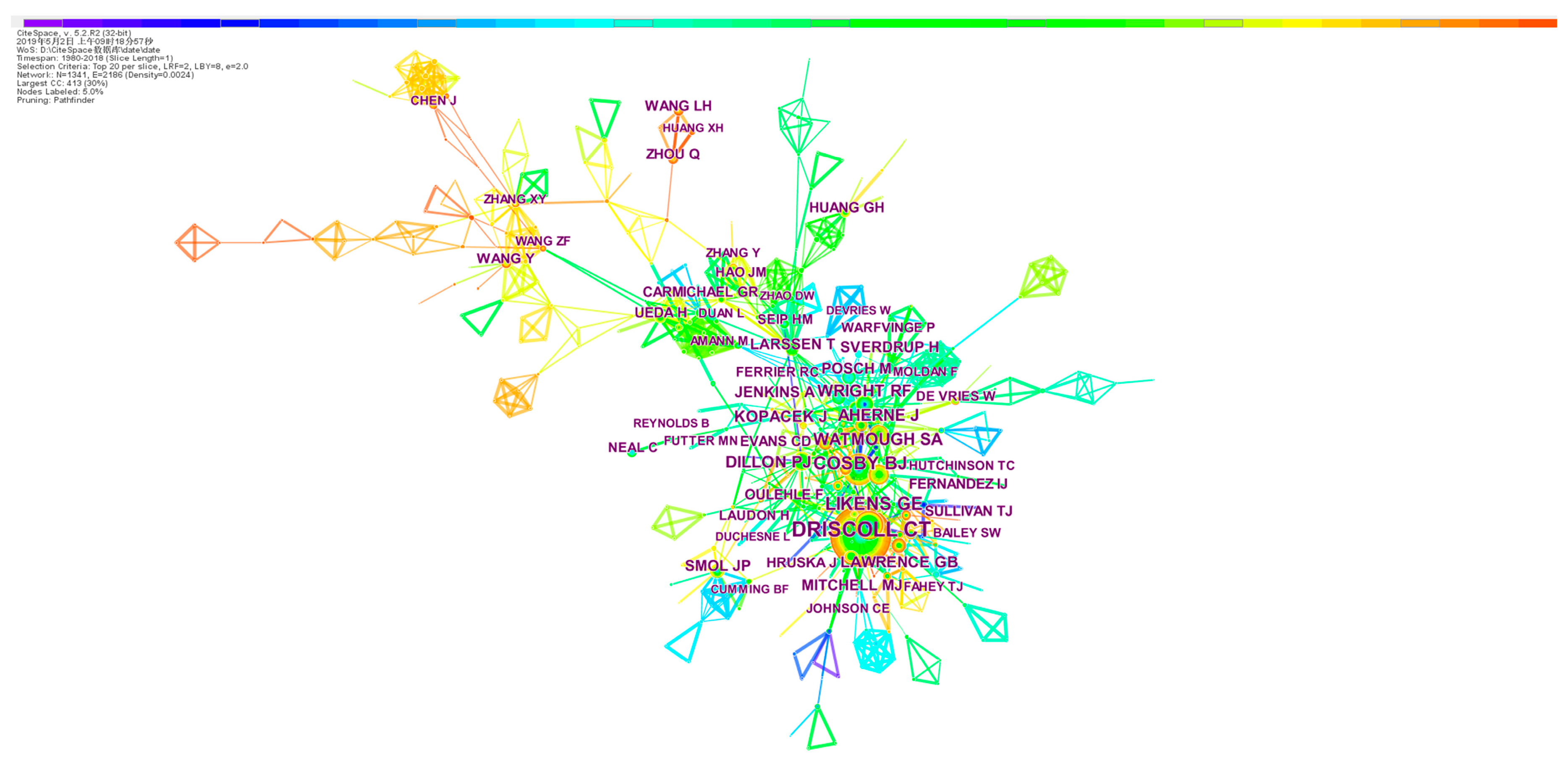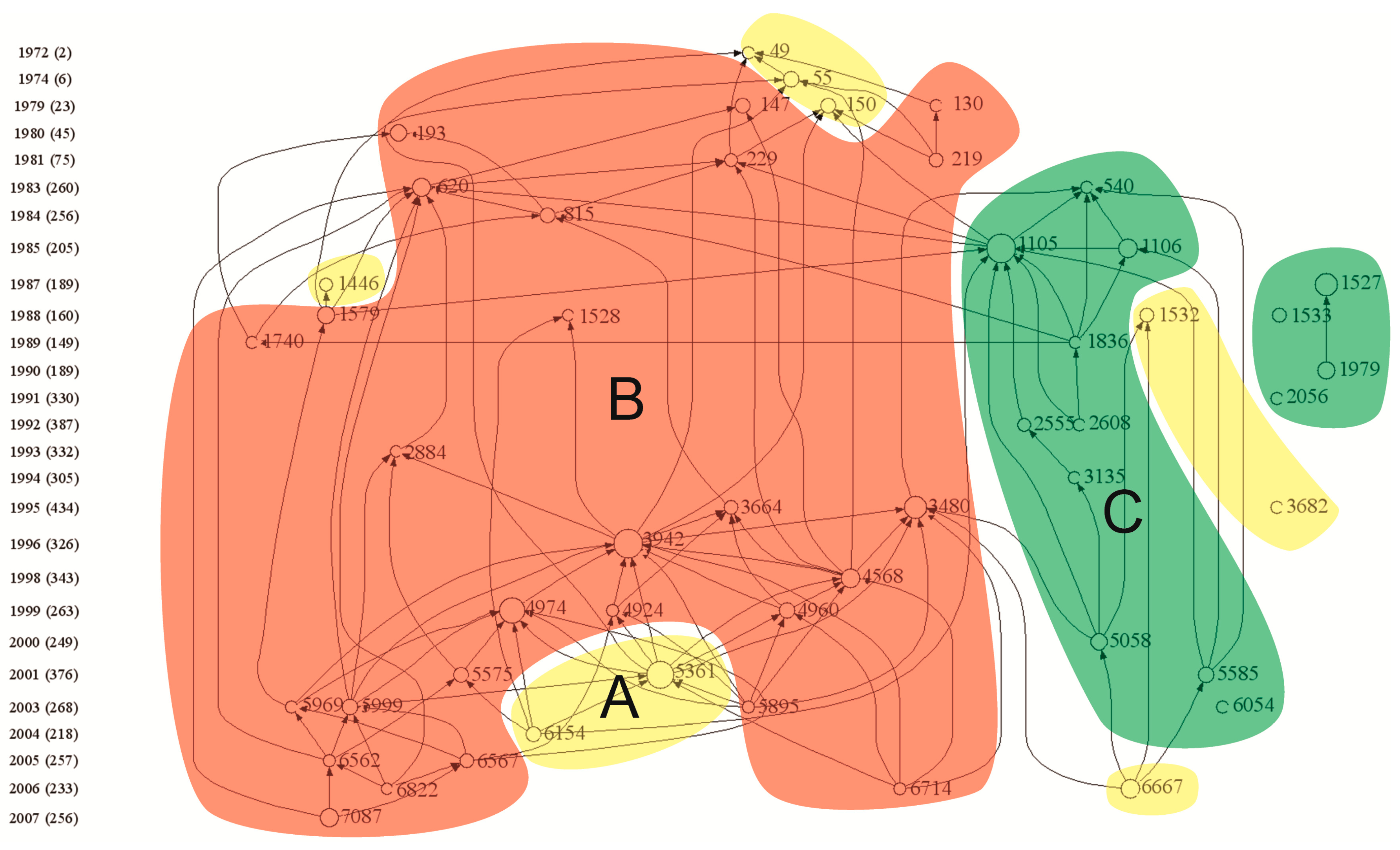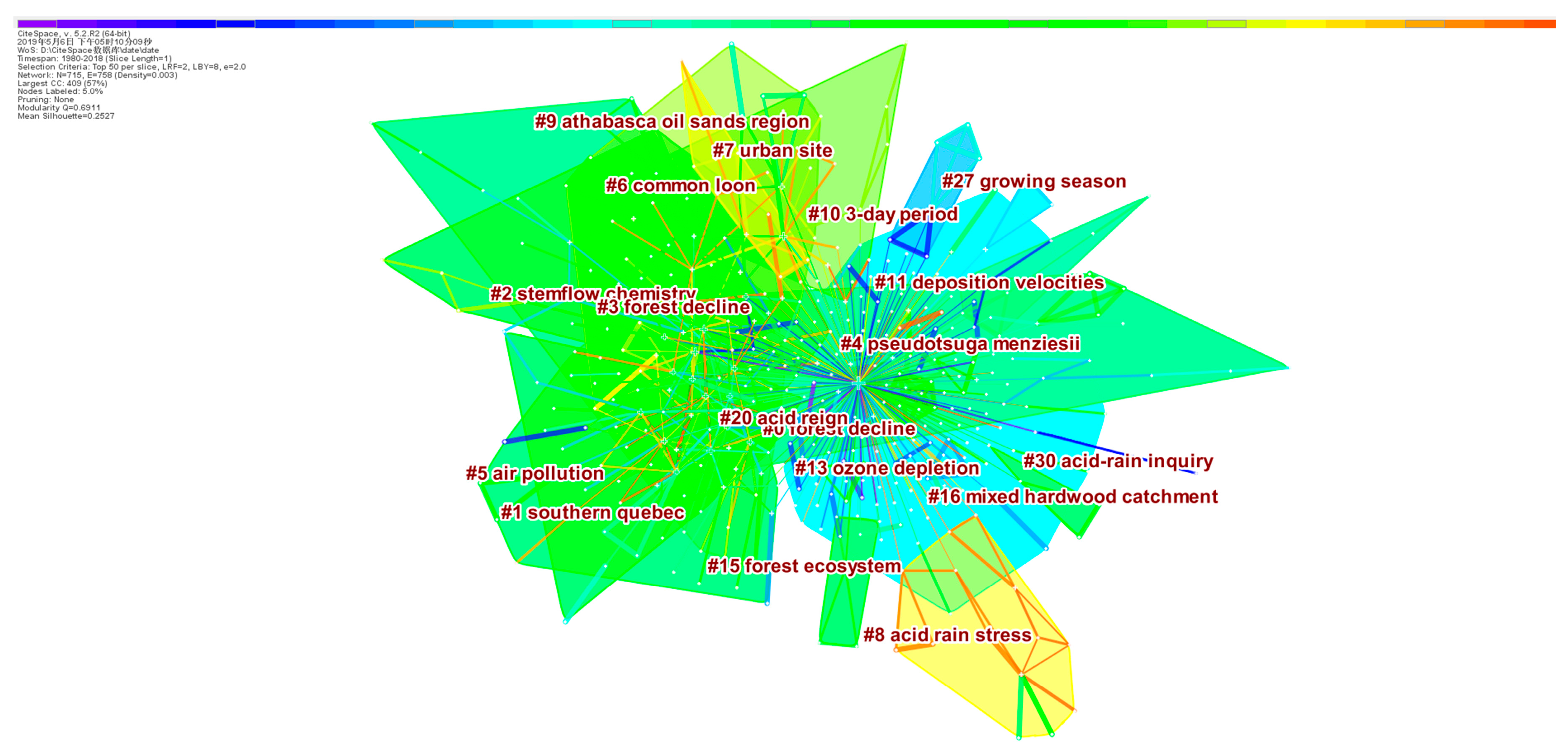3.2. Research Outputs and Citation
A total of 10,164 publications on AR were retrieved in this study, with the first one being indexed in 1900 [
15]. AR had not drawn much attention until the 1980s because few records were available before then (
Figure 2). Thereafter, it was recognized as a global environmental issue and started to receive extensive attention. However, it is interesting that there are two peaks regarding AR publications from 1980–2018 (
Figure 2). We can divide the development process of AR research into three stages. The first stage is from 1980 to 1989, where AR publication experienced an exponential increase from 1980 (20) to 1983 (260), and then a decrease from 1984 to 1989 (149). In central and northwestern Europe and the northeastern United States, acid precipitation occurred as a widespread phenomenon around the 1960s [
40,
41]. After that the visible and perceived effects of AR on ecosystems, including damage to plant growth and interference to aquatic organisms, were investigated [
40,
42]. Therefore, AR has attracted numerous researchers to study its effects on vegetation and chemical changes of soil and surface water since 1980 [
25,
28,
40,
43,
44,
45]. From 1984 to 1989, the focus of AR research was slightly shifted to model application for estimating and assessing temporal and spatial variations in the status and effects of acid deposition [
46,
47,
48]. The second stage is the period of 1990–2001. As we know, the signing of the 1990 Clean Air Act amendments is a milestone among many international agreements [
27]. These laws and agreements promoted AR research to control SO
2 and NO
X emissions and reduce AR. Therefore, AR reached a critical stage in its development during the period 1990–2001. However, the number of AR publications in this period fluctuated, and the year of 1995, notably, was the most active year, with the highest records (434). This result can be attributed to the influence and promotion of previous research studies to produce a peak in 1995. After 2001, as the third stage, more than 200 papers were published each year and the record revealed a stable and continuous increase, indicating that “AR” remains a hotspot in ecological researches.
Regarding the annual total local citations, the TLCS was “bell-shaped” over time and shifted consistently with the records (
Figure 2). This result indicated that the higher records, the more citations. The TLCS reached peaks in 1985 (1238) and 1995 (2230), indicating that some highly-cited publications appeared in these years. For instance, two highly-cited papers related to model application in the AR field were published in 1985 [
47,
48]. The paper titled “A new mechanism for calcium loss in forest-floor soils” is another highly-cited paper published in top journal
Nature in 1995 [
49]. However, the TLCS rapidly declined after 2005. The sharp falloff of TLCS since 2005 does not necessarily signify that there were no high-quality articles, but rather that it always requires several decades for articles to be recognized and widely cited [
50].
3.7. Research Hotspots in AR Domain
Through the citation network analysis on the highly cited articles, we can comprehend the status of development over time and identify the research hotspots in this area. As shown in
Figure 8, we selected the top 50 most cited publications in the AR research area to construct the citation network. According to the topics and contents of these papers, all of the 50 highly cited publications can be categorized into three relatively isolated panels (A, B, and C) that represent three research hotspots.
The hotspot A (marked in yellow) reviewed the status of AR and its control policies in Europe, the United States, and China over the past decades. It began with three papers (node 49, 55, and 150). The first highly cited paper (49) pointed out that rain and snow had been increasingly more acidic in northwestern Europe due to increasing emissions of sulfur and nitrogen oxides, which resulted in precipitation with pH values between 3 and 5 [
41]. Then, another paper (55) published in the top journal
Science revealed that acid deposition encompassed most of the northeastern United States with a pH value below 4.4 due to the industrial source in the Midwest, and H
2SO
4, HNO
3, and HCl accordingly contributed 65%, 30%, and less than 5% of the acidity in acid deposition, respectively [
51]. Thereafter, Likens et al. (150) [
52] reported that the acidity of precipitation had increased sharply in northwestern Europe and eastern North America in the past decades and this trend was closely linked to the emissions of sulfur and nitrogen oxides due to fossil fuel combustion. Subsequently, Zhao’s paper (1532) [
53] provided an overview of the serious AR situation in China and illustrated that approximately 90% of areas were covered by AR in the south of the Yangtze River in China, especially in Sichuan, Guizhou, and Jiangxi provinces. Moreover, they found NH
4+ and Ca
2+ were the major cations, while anions were dominated by SO
42− and the occurrence of AR depended not only on high SO
2 emission in the atmosphere, but also upon the amount of alkaline substances available, which acted as neutralizers (such as alkaline dust and NH
3). Galloway (3682) [
54] concluded that the emissions of SO
2, NO
X, and NH
3 would substantially increase in the developing world in the future. By 2020, the total amount of these source emissions in Asia would possibly be equal to, or greater than, the sum of Europe and North America. Recently, China has developed a policy for AR mitigation by adopting a 20% emission reduction goal from 1995 to 2010 within the AR control zone and great efforts have been made to improve the awareness of AR and related effects in China [
12]. In Europe and the United States, many policies, such as the Clean Air Act (CAA), adopted in 1970 and the Convention on Long-range Transboundary Air Pollution (LRTAP), signed in 1979, have been implemented to control air pollution and reduce AR in the past decades [
27]. What is more, to evaluate an overall development status of AR in United States, Driscoll et al. [
55] made a comprehensive review from the following aspects: sources and inputs, ecosystem effects, and management strategies, which received the most citations in this hotspot.
Due to the implementation of AR control policy and reduction measures in North America, Europe, and Asia, the basic research studies on AR were required to support the formulation of AR control policy and air pollution reduction measures. Based on this background, studies focused on the ecological consequences of AR on plant histological, physiological, and biochemical traits, as well as surface water and soil properties had become another hotspot (B, marked in red). This research hotspot started with two studies. One is Evans’s paper (130), in which the authors investigated leaf surfaces and anatomical lesions under simulated AR and found that the sensitivity and alterations of plants foliage to AR mainly depended on the plant species [
42]. Another highly-cited paper (147) published in
Science revealed that soil leaching and mineral weathering by acid precipitation were two dominant contributions to high concentrations of dissolved aluminum being transferred to surface and ground waters in the United States and Europe, which consequently led to aquatic organism mortality [
56]. However, there was still controversy on the effects of AR, with some researchers concluding that AR acidified soil and surface water, while others claiming that sometimes internal protons in soil could overshadow the effects of AR. Based on this fact, many researchers started to clarify which source was dominant among the atmospheric acid inputs (external hydrogen ions) and internal protons (cation assimilation and organic acid deprotonation) [
25,
28]. In acidic soils, external protons (H
+) usually exceed internal loading, leading to soil acidification by Al dissolution and sulphate retention [
25]. Following this, Schindler [
57] synthesized some possible mechanisms that led to acidification in lakes and freshwater. After that, a new mechanism for acidification in lakes and streams was proposed. Aluminum-induced reductions of Ca storage in soil resulted in decreased neutralization of drainage waters, thereby leading to acidification of lakes and streams [
49]. Likens proposed that the recovery of soil and stream water chemistry was significantly delayed because of a large amount of Ca and Mg lost from soil and leached out, although the atmospheric acid deposition decreased [
58], which received 335 LCS and ranked the first, as shown in
supplementary Table S1. Since then, DeHayes et al. (4960) revealed the mechanism on how AR altered the foliar Ca pool in red spruce and attributed this physiological disruption to enhanced freezing injury susceptibility under AR [
59]. Although emissions regulations had contributed to declining acid deposition in North America and Europe, recovery of surface water chemistry was insufficient because the substantial decline of base-cation concentration exceeded the decrease of sulphate concentration [
60]. Further research revealed that the effect of AR on cation leaching depended not only on the pH of AR but also on the original soil pH [
24]. Lately, an increase of dissolved organic carbon (DOC) concentration in surface water and its mechanisms have aroused much attention. Monteith et al. (7087) [
61] demonstrated that the increase of DOC concentration was proportional to the rate of the decline of atmospheric sulphur deposition. Because of co-occurrence of AR and other pollutants (such as heavy metal pollution) in the AR zone, the research on the interactions among AR and other pollution emerged as a new trend in the AR field [
57,
62]. For instance, Wen et al. considered the combined effects of lanthanumion and AR on the growth, photosynthesis, and chloroplast ultrastructure of soybean seedlings, because AR can change the bioavailability of lanthanumion in soil [
62].
In the process of AR research development, model applications for quantitatively assessing the acid deposition and its effects on terrestrial and aquatic ecosystems at regional scale became the third hotspot (C, marked in green). Nodes 1105 and 1106 were two representative articles, in which a conceptual model was built to estimate the gross chemical changes in the soil, soil water, and surface water of the catchment under acid deposition. This model used a lumped-parameter to represent the complex soil chemical processes and the predicted values of soil properties (such as pH and base saturation) were reliably consistent with the measurements [
47,
48]. Then, Chang et al. [
46] developed a three-dimensional Eulerian model to evaluate chemical components of acid deposition in North America, especially to determine the relative contribution among physical and chemical processes to acid deposition. Soon after, Stockwell [
63] presented the second generation Regional Acid Deposition Model (RADM2) for modeling atmospheric chemistry on a regional scale and it was proven to reliably predict sulfate and nitric acid concentrations. In the early 2000s, The Model of Acidification of Groundwater In Catchments (MAGIC model) was applied to predict soil acidification in southwest China and it was found that serious soil acidification had been going on over the last several decades [
64,
65]. Further, the long-term (1880–2030) trends of SO
2, NO
X, and NH
3 in European freshwater sensitive regions had been calculated. The results showed that SO
2, NO
X, and NH
3 will accordingly decrease 66%, 45%, and 16% until 2030 [
66]. In this hotspot, many models had been proposed, adjusted, upgraded, and implemented to predict the trend of AR and its effects on a regional scale.
3.8. Term Co-Occurrence Network Analysis
Compared to the citation network or co-word analyses, term co-occurrence analysis can offer a more comprehensive and reliable perspective on the structure of a specific field over time [
34]. Term cluster analysis can organize similar terms together and generate clusters on the basis of these terms that represent corresponding research areas. In this process, we used log-likelihood ratio (LLR) method to label the clusters, which enabled us to obtain the best result in terms of the uniqueness and coverage of themes within a cluster [
35].
Figure 9 presents the term-based network from 1980–2018. It should be noted that there were several indexes related to the clusters. Size index indicates the numbers of terms in the corresponding clusters. Silhouette index represents the homogeneity level of a cluster [
32]. This varies between 0 and 1. The closer it is to 1, the higher the cluster homogeneity. Once it is above 0.5, the cluster result is highly reliable and rational [
33,
35]. The parameter of Mean (Year) reflects the average year of the terms in a specific cluster, which is valuable to determine whether the cluster is new or old [
32]. Then, we listed the top 10 clusters in
Table 6 and found the silhouette values of all ten clusters were greater than 0.5, indicating the clusters were reasonable.
Among the top 10 clusters, we can divide the clusters into three stage (1990–2000, 2001–2010, and 2011–2018) in terms of the mean (year) index. We found different focuses for the three stages. In the period of 1990–2000, five cluster IDs 0, 1, 2, 4, and 5 were included. Forest decline had been observed in Asia, Europe, and North America due to air pollutants (acid deposition) [
58,
67]. The phenological events and characteristics were closely related to environmental factors (water, temperature, nutrient availability, etc.) [
67]. Therefore, whether and how acid deposition could affect the foliar phenological events aroused much attention. Shan et al. [
67] found that direct AR and indirect soil acidification were the main contributors to phenological disorder and forest decline. The acid deposition in southern Quebec had been considered serious and a series of effects of AR on forests and lakes had been studied, especially changes in forest soil chemistry (i.e., concentrations of major and trace elements) [
68,
69]. Links between ion concentrations (such as SO
42−, NO
3−, NH
4+, and PO
3−) in stemflow and epiphytic lichen diversity was another interesting topic. Many investigations in Harz mountain concluded that epiphytic lichen had a relatively higher diversity in AR affected forests than the healthy ones due to reduced canopy surfaces and lower ion concentrations in stemflows in affected forests [
70,
71]. The cluster ID 5 mainly focused on the spectral reflectance response of lichen
Ramalina duriaei to AR and air pollution that was derived from the combustion of heavy fuel oil in urban-industrial sites [
72,
73].
For 2001 to 2010, there are three involved clusters. We found cluster ID 3 was similar to cluster ID 0; “forest decline” and “phenological disorder” were still topics in the period of 2001–2010, but the topic “atmospheric nitrogen deposition” emerged as a more specific aspect, which mainly concentrated on the effects of nitrogen on ecosystems compared to acid deposition. The cluster ID 6 investigated changes in the reproduction of common loon (
Gavia immer) under acid precipitation [
74]; this is a crucial bioindicator species related to acid precipitation. Nova Scotia had become a susceptible area where AR-induced surface water acidification had led to a dramatic drop in the Atlantic Salmon population [
75]. With the continuous extension of the AR area, urban sites also suffered from acid pulses. The chemical characteristics of rainwater and wet precipitation in many urban sites had been observed by this point [
14,
76].
With the rapid development in the AR field, potential mechanisms of AR effects appear to have received more attention. For example, Wang et al. [
77] used the photosynthetic parameters (photosynthesis, chlorophyll content, chlorophyll fluorescence, etc.) of McClure seedlings to indicate their tolerance to AR stress. Additionally, the response of antioxidative systems and comprehensive transcriptomes to AR was also analyzed [
78,
79]. The Athabasca oil sands region is the largest area for open-pit oil sand mining in Alberta, Canada. Soil and water acidification in this area under dry and wet deposition is of high concern to government, industry, and the public, making it a hotspot in the AR field [
80].
